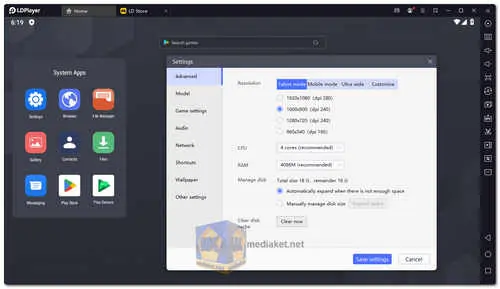LDPlayer is a free Android emulator that allows you to run Android games and apps on your PC. It is one of the most popular Android emulators, and it is known for its high performance and compatibility. LDPlayer is also very customizable, so you can tweak it to your liking...
LDPlayer is designed specifically for gamers, and it offers a number of features that make it ideal for playing mobile games on PC. These features include:
High performance:
LDPlayer is one of the fastest Android emulators available, and it can handle even the most demanding games without any lag.
Keyboard mapping:
LDPlayer allows you to map keyboard and mouse controls to your Android games, giving you a more precise and responsive gaming experience.
Multi-instance:
LDPlayer allows you to run multiple Android instances simultaneously, so you can play different games at the same time.
Customization:
LDPlayer is highly customizable, and you can adjust a variety of settings to optimize your gaming experience.
In addition to its gaming features, LDPlayer also offers a number of other features that make it a versatile Android emulator. These features include:
Support for Google Play Store:
LDPlayer comes pre-installed with the Google Play Store, so you can easily download and install Android apps and games.
Support for root access:
LDPlayer allows you to root your Android instance, which gives you access to a wider range of features and functionality.
Support for custom ROMs:
LDPlayer allows you to install custom ROMs on your Android instance, giving you even more control over your gaming experience.
It is available for Windows 7, 8, 10, and 11.
LDPlayer is a free and easy-to-use Android emulator that offers a wide range of features for gamers and developers alike. If you are looking for a powerful and versatile Android emulator, then LDPlayer is a great option.
Here are some potential pros of using LDPlayer:
Performance:
LDPlayer is known for its impressive performance, offering smooth and fast emulation, especially for resource-intensive games and applications. It utilizes virtualization technology, like VT and AMD-V, to enhance performance further.
Multiple Instances:
LDPlayer allows users to create multiple virtual Android devices, enabling them to run different apps and games simultaneously on the same computer.
Customization:
The emulator offers a range of customization options, such as resolution, CPU, RAM allocation, and device model settings, which can be adjusted to match the user's preferences and system capabilities.
Ease of Use:
LDPlayer has a user-friendly interface, making it easy for both beginners and experienced users to navigate and utilize its features.
Keymapping and Controller Support: LDPlayer supports keymapping, allowing users to map keyboard and mouse controls to touchscreen actions, making it convenient for playing games that require touch input. Additionally, it also supports external controllers.
Regular Updates: The LDPlayer team frequently releases updates to improve performance, add new features, and ensure compatibility with the latest Android versions and games.
LDPlayer is a capable Android emulator with many positive aspects, particularly its performance and ease of use.
LDPlayer - Changelog:
Fixed known issues.
Size: 650.23 MB
Here's a step-by-step guide on how to use LDPlayer:
1. Download and Install LDPlayer:
- Download the LDPlayer installer suitable for your operating system.
- Run the installer and follow the on-screen instructions to install LDPlayer on your computer.
2. Configure LDPlayer:
- Once LDPlayer is installed, launch the emulator.
- The first time you run it, you will be asked to set up some initial settings like the language, screen resolution, and whether you want to create a desktop shortcut. Configure these settings according to your preferences.
3. Google Account Setup (Optional):
- LDPlayer allows you to use Google Play Store and access your Google account. To do this, click on the "System Apps" icon on the desktop and then open the "Google Play Store." Follow the on-screen instructions to sign in with your Google account.
4. Install Apps and Games:
- You can install Android apps and games in several ways:
- If you have the APK file, you can drag and drop it onto the LDPlayer window to install it.
- You can also use the Google Play Store to search for and install apps and games directly.
- LDPlayer may also have its own app store where you can find and install apps.
5. Use LDPlayer:
- Once apps and games are installed, you can launch them by clicking on their icons on the LDPlayer desktop or in the app drawer.
6. Customize LDPlayer Settings:
- LDPlayer provides various settings to customize your emulator experience. You can access these settings by clicking on the gear icon in the upper-right corner of the LDPlayer window. Here, you can adjust CPU and RAM allocation, resolution, keyboard mapping, and more.
7. Keyboard Mapping:
- If you are playing games, you may want to customize the keyboard mapping to suit your preferences. LDPlayer allows you to map keyboard keys to touchscreen controls. You can access this feature through the keyboard icon on the sidebar.
8. Multi-Instance:
- LDPlayer also supports running multiple instances simultaneously. This can be useful if you want to run multiple apps or games on separate virtual devices. You can create and manage multiple instances from the Multi-Instance Manager in the sidebar.
9. Performance Optimization:
- LDPlayer offers various performance optimization options, such as changing the number of CPU cores allocated to the emulator, enabling VT (Virtualization Technology) in your computer's BIOS for better performance, and updating your graphics drivers.
10. Regular Updates:
- Keep your LDPlayer emulator updated to ensure you have the latest features, improvements, and compatibility with new apps and games.
That's a basic overview of how to use LDPlayer. Keep in mind that LDPlayer's interface and features may evolve over time, so it's a good idea to refer to the official LDPlayer documentation or website for the most up-to-date information and troubleshooting guides if you encounter any issues.

